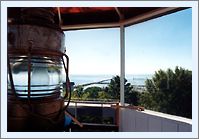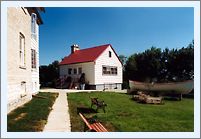|
Historical
Information

Wooster Harrison and a number of other white traders and land
speculators arrived at the mouth of the Sauk River in 1835 and
established the settlement of Washington City. The settlement grew
quickly, and by 1845 churches, stores and a schoolhouse sprang up to
support the fishing and lumber trade growing at the river mouth. With
its commercial success tied to the burgeoning number of vessels entering
the harbor, the city founders began lobbying their legislators for aids
to navigation to serve the growing maritime commerce.
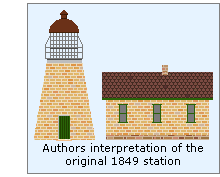 Taking up their call, Representative
Henry Dodge presented a petition before the House of Representatives on
February 25, 1845 on behalf of the residents of the Wisconsin Territory
for the construction of a lighthouse at the harbor entrance. After the
town's appointment as the county seat in 1847, Representatives Morgan L.
Martin and John Hubbard Tweedy subsequently added their support to the
cause, presenting similar memorials signed by prominent Wisconsin
business interests before Congress. As a result of the mounting
pressure, Congress deferred the matter to the Committee on Commerce on
January 31, 1848 with instructions to "inquire into the expediency
of making appropriations, at the present session, for the erection of a
light-house at Sauk harbor, in the Territory of Wisconsin " After
evaluation, the Commerce Committee concurred that the need for a
lighthouse at the harbor was both valid and desirable, and Congress
appropriated the sum of $3,500 for the building's construction on June
26, 1848, the same year in which the village was renamed Port Washington
to better reflect its growing maritime significance. Taking up their call, Representative
Henry Dodge presented a petition before the House of Representatives on
February 25, 1845 on behalf of the residents of the Wisconsin Territory
for the construction of a lighthouse at the harbor entrance. After the
town's appointment as the county seat in 1847, Representatives Morgan L.
Martin and John Hubbard Tweedy subsequently added their support to the
cause, presenting similar memorials signed by prominent Wisconsin
business interests before Congress. As a result of the mounting
pressure, Congress deferred the matter to the Committee on Commerce on
January 31, 1848 with instructions to "inquire into the expediency
of making appropriations, at the present session, for the erection of a
light-house at Sauk harbor, in the Territory of Wisconsin " After
evaluation, the Commerce Committee concurred that the need for a
lighthouse at the harbor was both valid and desirable, and Congress
appropriated the sum of $3,500 for the building's construction on June
26, 1848, the same year in which the village was renamed Port Washington
to better reflect its growing maritime significance.
The
Treasury Department responded quickly, purchasing a reservation on the
bluff to the north side of the harbor for $200 and awarding a contract
for the station's construction that same year. Typical of lighthouse
construction under the Pleasonton Administration, local building
materials were used for as much of the station as possible in order to
keep construction costs low. With large deposits of lacustrine clay in
the area, which after firing created the yellow brick that would
eventually become universally known as Cream
City brick, it is no surprise that this material was used in the
construction of both the tower and dwelling. While little is known of
the exact specifications for these two structures, it is likely that the
station appeared similar to the illustration to the left, which was the
common building plan being used on the Great Lakes at that time. The
tower stood around thirty feet in height, and was equipped with a
birdcage-style lantern with housed an array of 5 Lewis lamps equipped
with 14-inch reflectors. Cyrus Worth was appointed as the station's
first keeper, and he climbed the stairs to light the lamps for the first
time on the night of May 8, 1849.
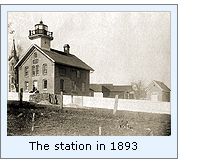 In his inspection of the station on
July 5th of the following year, Henry B Miller, the Superintendent and
Inspector of the Lights of the Northwest Lakes reported that the station
had "thus far stood the effects of the weather" and was in
good condition. However, he recommended that the sum of $75 be
appropriated to allow the keeper to finish the two rooms on the second
floor of the dwelling to provide additional living quarters. With the
creation of the Lighthouse Board in 1853, a system-wide upgrading of the
illuminating apparatus in the nation's lighthouses was undertaken. This
upgrade involved the replacement of the Lewis lamps with the far
superior Fresnel lenses manufactured in France. To this end, the
original Port Washington lighting system was removed in 1855, and
replaced with a fixed white Sixth
Order Fresnel lens. In his inspection of the station on
July 5th of the following year, Henry B Miller, the Superintendent and
Inspector of the Lights of the Northwest Lakes reported that the station
had "thus far stood the effects of the weather" and was in
good condition. However, he recommended that the sum of $75 be
appropriated to allow the keeper to finish the two rooms on the second
floor of the dwelling to provide additional living quarters. With the
creation of the Lighthouse Board in 1853, a system-wide upgrading of the
illuminating apparatus in the nation's lighthouses was undertaken. This
upgrade involved the replacement of the Lewis lamps with the far
superior Fresnel lenses manufactured in France. To this end, the
original Port Washington lighting system was removed in 1855, and
replaced with a fixed white Sixth
Order Fresnel lens.
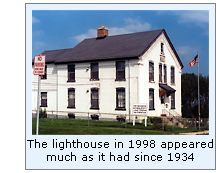 As
was the case with virtually all of the early stations built under the
"least cost" tenets of the Pleasonton Administration, the
structure at Port Washington began to deteriorate quickly, and by the
end of the 1850's, the Lighthouse Board began planning for the
replacement of both the tower and dwelling. Work on the new structure
began in 1859, and continued into 1860. The new structure consisted of a
two-story cream city brick structure with a white painted timber tower
integrated into the southeast end of the roof ridge. A steep stairway
through the attic provided access to the lantern, which was supported by
four massive hand-hewn timbers which transferred the load of the tower
and cast iron lantern all the way through the structure directly to the
foundation. The Sixth Order Fresnel was transferred from the old tower,
and with a distance of 40 feet from ground level to the center of the
lens, the station boasted an impressive focal plane of 113 feet above
the level of the lake, and was visible for a distance of nine miles in
clear weather. A woodshed, privy and barn for the Keeper's horse rounded
out the station's complement of structures. As
was the case with virtually all of the early stations built under the
"least cost" tenets of the Pleasonton Administration, the
structure at Port Washington began to deteriorate quickly, and by the
end of the 1850's, the Lighthouse Board began planning for the
replacement of both the tower and dwelling. Work on the new structure
began in 1859, and continued into 1860. The new structure consisted of a
two-story cream city brick structure with a white painted timber tower
integrated into the southeast end of the roof ridge. A steep stairway
through the attic provided access to the lantern, which was supported by
four massive hand-hewn timbers which transferred the load of the tower
and cast iron lantern all the way through the structure directly to the
foundation. The Sixth Order Fresnel was transferred from the old tower,
and with a distance of 40 feet from ground level to the center of the
lens, the station boasted an impressive focal plane of 113 feet above
the level of the lake, and was visible for a distance of nine miles in
clear weather. A woodshed, privy and barn for the Keeper's horse rounded
out the station's complement of structures.
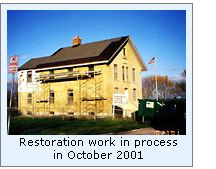 In
order better serve the needs of mariners coasting the western lake
shore, the Sixth Order lens was replaced by a fixed white Fourth
Order lens in 1870, with a corresponding increase in its range
of visibility to 18 miles in clear weather. Also during the 1870's, the
Army Corps of Engineers began a series of upgrades and replacements to
the private piers which served to form the harbor. While the old light
on the bluff to the north of the harbor continued to serve as a guide to
mariners off shore, it served virtually no assistance in guiding them
through the 120-foot opening between the thousand-foot long protective
piers which were being built. To this end, on the completion of the
piers, the Army Corps of Engineers constructed a wooden tower on the
North pier in 1889. Consisting of a pyramidal skeletal structure, its
upper portion was enclosed to serve as a room for working on the lamps
and as refuge from foul weather while tending the light. The tower was
capped by an octagonal cast iron lantern and housed a fixed red Fourth
Order lens with a focal plane of 42 feet 6 inches. Charles H Lewis Jr.,
who had taken over as Keeper of the Port Washington Light in 1880 on his
father's death, was now responsible for maintaining both lights. To
provide much needed assistance with the new light, George Rathbun was
assigned as the station's first Assistant Keeper on March 10. 1889. In
order better serve the needs of mariners coasting the western lake
shore, the Sixth Order lens was replaced by a fixed white Fourth
Order lens in 1870, with a corresponding increase in its range
of visibility to 18 miles in clear weather. Also during the 1870's, the
Army Corps of Engineers began a series of upgrades and replacements to
the private piers which served to form the harbor. While the old light
on the bluff to the north of the harbor continued to serve as a guide to
mariners off shore, it served virtually no assistance in guiding them
through the 120-foot opening between the thousand-foot long protective
piers which were being built. To this end, on the completion of the
piers, the Army Corps of Engineers constructed a wooden tower on the
North pier in 1889. Consisting of a pyramidal skeletal structure, its
upper portion was enclosed to serve as a room for working on the lamps
and as refuge from foul weather while tending the light. The tower was
capped by an octagonal cast iron lantern and housed a fixed red Fourth
Order lens with a focal plane of 42 feet 6 inches. Charles H Lewis Jr.,
who had taken over as Keeper of the Port Washington Light in 1880 on his
father's death, was now responsible for maintaining both lights. To
provide much needed assistance with the new light, George Rathbun was
assigned as the station's first Assistant Keeper on March 10. 1889.
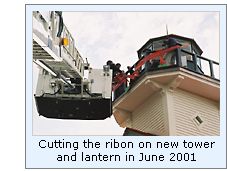 1894 saw the construction of a brick
oil house at the main light along with a cement sidewalk connecting the
dwelling and the woodshed. Five years later, a 255 foot steel fence with
a new carriage gate was erected round the property and six loads of
gravel were placed on the drive which lead to the station barn. By 1903,
it was finally realized that the old light atop St. Mary's Hill was no
longer serving any real purpose, since most vessels were using the
equally bright North Pierhead light to gain their bearings. Thus the
decision was made to eliminate the old lighthouse, and to continue use
of the building solely as a dwelling for the keepers. Although the main
light was discontinued, the lantern continued to sit empty atop the
structure. 1894 saw the construction of a brick
oil house at the main light along with a cement sidewalk connecting the
dwelling and the woodshed. Five years later, a 255 foot steel fence with
a new carriage gate was erected round the property and six loads of
gravel were placed on the drive which lead to the station barn. By 1903,
it was finally realized that the old light atop St. Mary's Hill was no
longer serving any real purpose, since most vessels were using the
equally bright North Pierhead light to gain their bearings. Thus the
decision was made to eliminate the old lighthouse, and to continue use
of the building solely as a dwelling for the keepers. Although the main
light was discontinued, the lantern continued to sit empty atop the
structure.
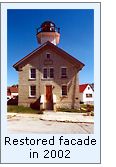 With the electrification of the
Pierhead Light in 1924, responsibility for its operation was transferred
to the Port Washington City Electrical Utility. No longer needed to
serve his light, Keeper Lewis resigned from Lighthouse service after 44
years at Port Washington, and Assistant Arthur S Almquist transferred to
Racine Breakwater Light. With the electrification of the
Pierhead Light in 1924, responsibility for its operation was transferred
to the Port Washington City Electrical Utility. No longer needed to
serve his light, Keeper Lewis resigned from Lighthouse service after 44
years at Port Washington, and Assistant Arthur S Almquist transferred to
Racine Breakwater Light.
Exactly
what happened to the old Main Light building over the next ten years is
unclear until 1934, when the new Breakwater Light and fog signal were
constructed. With Keepers again needed to man the maintenance intensive
fog signal, the old main light underwent a major renovation to convert
it into a duplex dwelling to provide living accommodations for the new
keeper and his assistant. As part of this renovation. the tower and
lantern were removed from the roof along with the four massive tower
support beams, attic stairs, and the oil storage shed. At this time, the
building was also given a coat of white paint. Thus modified, the
building no longer gave any hint of its original purpose or its
historical significance beyond the chiseled "1860" which
remained proudly displayed above the main entryway.
After the complete automation of the
Breakwater Light n the mid 1970's, the old building continued to house a
group of Station Milwaukee Coast Guardsmen assigned to Port Washington.
When this post was eliminated in 1992, the Coast Guard leased the
building to the Port Washington Historical Society, which used the
structures as a museum, with the long term goal of restoring the station
to its turn of the twentieth century appearance. In 1998, permanent
ownership of the structure was transferred to the City of Port
Washington with oversight by the National Park Service, and the way was
set for restoration, and the planning process began in earnest.
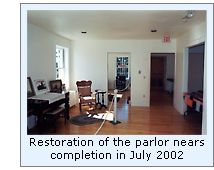 In a serendipitous stroke of luck, the
Minster of Sites and Monuments for the Luxembourg Government was
visiting the area in 2000 as a result of the area's large population of
Luxembourg emigrants. While at the lighthouse museum, he was impressed
with the old structure and the Historical Society's plans for
restoration. As a result, The Grand Duchy of Luxembourg offered to build
a replacement tower and lantern, and to have it shipped to Port
Washington along with the craftsmen necessary to install the structure
on the old building in the spring of 2002 as a memorial to US service
men who fought for the freedom of the Grand Duchy in the Second World
War. In a serendipitous stroke of luck, the
Minster of Sites and Monuments for the Luxembourg Government was
visiting the area in 2000 as a result of the area's large population of
Luxembourg emigrants. While at the lighthouse museum, he was impressed
with the old structure and the Historical Society's plans for
restoration. As a result, The Grand Duchy of Luxembourg offered to build
a replacement tower and lantern, and to have it shipped to Port
Washington along with the craftsmen necessary to install the structure
on the old building in the spring of 2002 as a memorial to US service
men who fought for the freedom of the Grand Duchy in the Second World
War.
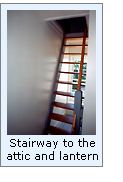 As a result of the added impetus of the
generosity of the Luxembourg Government, the Historical Society went
into overdrive, planning, fund raising and seeking additional grant
money. Restoration work began in October 2000, and continued throughout
the following year. As a result of its hard working determination, the
Port Washington Historical Society managed to get all the exterior
renovation complete in time, and the interior support columns replaced
and the stairway in the attic rebuilt in time for the arrival of the
Luxembourg craftsmen with their new tower in the spring of 2002. The
tower and lantern were carefully hoisted atop the roof, which was
refurbished with a historically accurate red metal shake style roof
similar to those installed at Grand Traverse and Whitefish Point. As a result of the added impetus of the
generosity of the Luxembourg Government, the Historical Society went
into overdrive, planning, fund raising and seeking additional grant
money. Restoration work began in October 2000, and continued throughout
the following year. As a result of its hard working determination, the
Port Washington Historical Society managed to get all the exterior
renovation complete in time, and the interior support columns replaced
and the stairway in the attic rebuilt in time for the arrival of the
Luxembourg craftsmen with their new tower in the spring of 2002. The
tower and lantern were carefully hoisted atop the roof, which was
refurbished with a historically accurate red metal shake style roof
similar to those installed at Grand Traverse and Whitefish Point.
On
June 16, 2001 dignitaries of the Luxembourg government arrived in Port
Washington and in front of news cameras and the world, the new tower was
officially dedicated, and the station returned to her original glory.
The Historical Society has plans to continue restoring the interior of
the station, and to make it into one of the Great Lakes first-class
maritime museum

Seeing this
Light

Click Here to see a complete listing of all Port Washington Old Light
keepers compiled by Phyllis L. Tag of Great Lakes Lighthouse Research.

Finding this Light

From the lake front, take Lake Street north to the intersection with
East Jackson Street. Turn west on East Jackson to the intersection with
North Franklin. Turn right on North Franklin to Woodruff, and turn right
on Woodruff. Turn right on North Catalpa Street to Van Buren Street.
Turn right on Van Buren and continue to North Johnson Street. Continue
on North Johnson as it makes a sweeping curve to the left, and you will
find the lighthouse on your left toward the end of the curve.

Contact information

The Port Washington Historical Society can be reached at (262)
284-7240.

Reference Sources
Annual Report of the Fifth Auditor 1850
Annual Reports of the Lighthouse Board, various, 1853 - 1909
Great Lakes Light Lists 1861, 1876 & 1901.
USCG Historians office, Photographic
archives.
Personal observation at Port Washington, 09/09/2000.
Photographs courtesy of Jeff Shook and Russ Babington.
Keeper listings for this light appear courtesy of Great
Lakes Lighthouse Research
|

